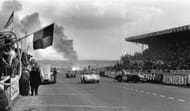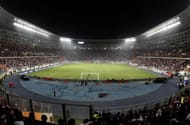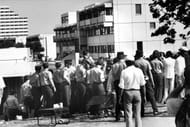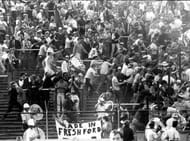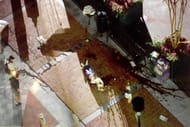If you look back into the 20th century, you will find that sporting disasters were in fact quite common then and their causes ranged from irate spectators to terrorist strikes to plane crashes. Here are a few of them from every decade of the last century, starting from the 40s.
Superga Air Disaster, 1949
Plane crashes and bombings have rocked the football fraternity a lot of times, including the 1958 Munich air disaster which wiped out half of the Manchester United team, known as the Busby Babes, and the Surinam Airways Flight 764 crash of 1989 which killed the entire team of Dutch Surinamese footballers known as the Colourful 11.
But it all started with the Superga Air Disaster of 1949, where the flight carrying all but two players of the Torino A.C. football team and their entire coaching staff crashed into a hill, killing all 31 on board. Torino was the best club in Italy, having won the Serie A three consecutive times. Not only did the Superga crash lead to the demise of the club, which could never fully recover, but it also meant disaster for the Italian national team, which consisted of 10 Torino players.
Le Mans Disaster, 1955
The racing track has witnessed many tragedies down the years, be it the legendary Ayrton Senna’s death at the San Marino Grand Prix, or the recent demise of the NASCAR driver Jason Leffler at a dirt car event.
But nothing can ever beat the Le Mans disaster that occurred during the 24 Hours of Le Mans race of 1955 where driver Pierre Levegh and 83 other spectators were killed and 120 others were injured. This terrible tragedy occurred when Levegh’s car crashed into the earthen embankment that separated the spectators from the track due to contact with the race car ahead of him. The crash sent parts of the car hurtling towards the spectators. Those who managed to survive the crash died from the embers flying out of the burning car.
Estadio Nacional Disaster, 1964
More famously known as the Lima football riot, this 1964 riot at Peru’s national stadium is the worst riot ever to occur in the history of association football, which claimed the lives of 320 spectators and injured 500 others. What sparked the riot was a disallowed goal by Peru when only two minutes were left for the match to end, with Peru well on their way to a defeat at the hands of Argentina by a margin of just one goal.
One goal and Peru would have levelled the scores. An irate and drunk spectator rushed onto the field jumping over the barricade that separated the stands from the field and the police shot tear gas canisters towards the northern grandstand to prevent others to follow suit. But the result was just the opposite as the spectators panicked and ran towards the exits, leading to a stampede.
Once out in the open, the crowd caused mass destruction of property all around the stadium due to what has become popular in psychology as the spill over effect.
Munich Massacre, 1972
There has probably never been a sporting disaster more outrageous and notorious than the massacre of 11 members of the Israeli Olympic team during the 1972 Summer Olympics in Munich. They were initially taken hostage and later shot in cold blood both before and during the subsequent futile rescue attempt by German border police, which also killed one of their officers.
The attack was perpetrated by eight members of the Palestinian terrorist group “Black September”. They demanded the release of 234 Palestinians and non-Arabs lodged in Israel’s jails along with two German terrorists. The attack could have been averted if, as claimed by the German newspaper Der Spiegel, Germany had acted on a tip-off regarding the attack instead of carrying on with their goal of hosting a “Carefree Games”.
Even the media was in part responsible for the tragedy: in an act of sheer stupidity and nonchalance, they broadcast live images of the police preparing to lodge an attack on the fidayeen, because of which the first attempt at an ambush had to be deserted. The only silver lining of the massacre was that it started a global wave of preparations for counter-terrorism to avert such a scenario, where the German police were clearly incompetent to match the fidayeen in any way, in the future.
Heysel Stadium Disaster, 1985 and Hillsborough Disaster, 1989
For the 80s decade, we have chosen two sporting disasters as they were of very similar nature: both involving football, Liverpool and infrastructural errors. While the Heysel Stadium disaster took place in Brussels just before the start of the European Cup final featuring Juventus and Liverpool, the Hillsborough disaster occurred in Sheffield during the FA Cup semi-final match between Nottingham Forest and Liverpool.
The Heysel Stadium disaster was a result of the boorish Liverpool fans attacking the Juventus fans which led to a stampede and a wall collapse, killing 39 spectators and injuring 600 others, and the Hillsborough disaster was a mixed result of the incompetence of the police and emergency services as well as the standing terraces that were much prevalent then, leading to the death of 96 spectators and the injury of 766 more.
Centennial Olympic Park Bombing, 1996
If it were the Israeli athletes who were the victims of the 1972 Munich massacre, this time it were the spectators. Twenty-four years after that dreaded attack in Munich, terrorists struck again; this time at the 1996 Summer Olympics being held in Atlanta, USA.
While the death toll from the blast was only one, with another person dying from a heart attack, the injury list included 111 spectators. The death toll would have been much higher if a security guard hadn’t discovered the bag containing the three pipe bombs, and begun evacuating the spectators from the area.
But alas, the bomb detonated before the Centennial Olympic Park could be cleared, resulting in the subsequent injuries to those who were nearby. Once again, a sporting event meant to be a harbinger of peace and brotherhood turned into a scene of utter horror and tragedy.
